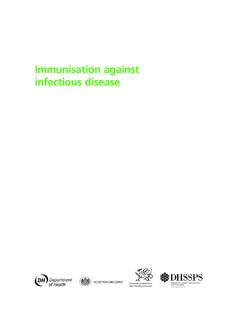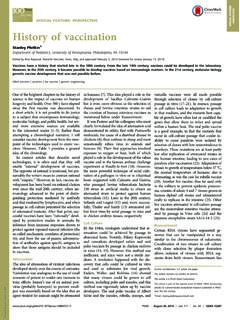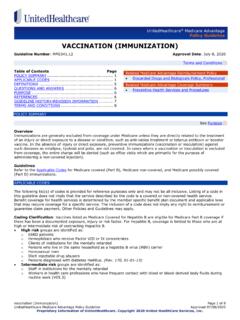Transcription of Multiple choice questions on immunisation against ...
1 Multiple choice questions on immunisation against infectious disease The Green Book Original version issued February 2008 Updated version January 2020 Withdrawn June 2022 Multiple choice questions on immunisation against infectious disease 2 About Public Health England Public Health England exists to protect and improve the nation s health and wellbeing and reduce health inequalities. We do this through world-leading science, research, knowledge and intelligence, advocacy, partnerships and the delivery of specialist public health services. We are an executive agency of the Department of Health and Social Care, and a distinct delivery organisation with operational autonomy. We provide government, local government, the NHS, Parliament, industry and the public with evidence-based professional, scientific and delivery expertise and support. Public Health England Wellington House 133-155 Waterloo Road London SE1 8UG Tel: 020 7654 8000 Twitter: @PHE_uk Facebook: Prepared by Drs Amelia Cummins, David Irwin, Sally Millership and Sultan Salimee, Consultants in Communicable disease Control For queries relating to this document, please contact: Health Protection Team, Second Floor, Goodman House, Station Approach, Harlow, Essex CM20 2ET, Tel: 0300 303 8537, Fax: 0300 303 8541 Crown copyright 2020 You may re-use this information (excluding logos) free of charge in any format or medium, under the terms of the Open Government Licence To view this licence, visit OGL.
2 Where we have identified any third-party copyright information you will need to obtain permission from the copyright holders concerned. Published March 2020 PHE publications PHE supports the UN gateway number: GW-1166 Sustainable Development Goals Withdrawn June 2022 Multiple choice questions on immunisation against infectious disease 3 Contents questions Chapter 1 Immunity and How Vaccines Work 5 Chapter 2 Consent 7 Chapter 3 Cold Chain 8 Chapter 4 immunisation Procedures 9 Chapter 5 immunisation by Nurses and Other Professionals 11 Chapter 6 Contraindications and special considerations 12 Chapter 7 immunisation of Those with Underlying Medical Conditions 13 Chapter 8 vaccine Safety and Adverse Events Following immunisation 15 Chapter 9 Surveillance and Monitoring for vaccine Safety 16 Chapter 10 vaccine Damage Payment Scheme 17 Chapter 11 immunisation Schedule 19 Chapter 12 immunisation of Healthcare and Laboratory Staff 21 Chapter 13 Anthrax 22 Chapter 14 Cholera 24 Chapter 15 Diphtheria 26 Chapter 16 Haemophilus Influenza
3 Type B (Hib) 28 Chapter 17 Hepatitis A 30 Chapter 18 Hepatitis B 32 Chapter 18a Human Papillomavirus 35 Chapter 19 Influenza 37 Chapter 20 Japanese encephalitis (JE) 40 Chapter 21 Measles 41 Chapter 22 Meningococcal 43 Chapter 24 Pertussis 47 Chapter 25 Pneumococcal 49 Chapter 26 Polio 52 Chapter 27 Rabies 53 Chapter 27a Respiratory Syncytial Virus 54 Chapter 27b - Rotavirus 56 Chapter 28 Rubella 58 Chapter 28a - Shingles 60 Chapter 29 - Smallpox 62 Chapter 30 Tetanus 63 Chapter 31 Tick borne encephalitis (TBE) 64 Chapter 32 Tuberculosis 65 Chapter 33 Typhoid 67 Chapter 34 Varicella 70 Chapter 35 Yellow Fever 72 Withdrawn June 2022 Multiple choice questions on immunisation against infectious disease 4 Introduction These MCQs have been devised to help you test your knowledge and understanding of each of the chapters of the 'Green Book immunisation against infectious disease '.
4 To make best use of the MCQs as a learning and revision tool we recommend that you read a chapter in detail before attempting the relevant questions . We have also prepared an answer key. To receive this answer key please e-mail quoting MCQs Green Book in the subject box, and stating: Your professional group (Paediatrician, CCDC, GP, Practice Nurse, Health Visitor, School Nurse, other - please state) The Region/Country in which you are working. Withdrawn June 2022 Multiple choice questions on immunisation against infectious disease 5 Chapter 1 Immunity and How Vaccines Work 1. Which of the following confer(s) passive immunity? a) Hepatitis B vaccine b) MMR vaccine c) Hepatitis B immunoglobulin d) Infection with measles virus e) Cross placental transfer of maternal antibodies 2. Immunoglobulins are made: a) In a laboratory from deactivated viruses and bacteria b) From the plasma of a person in the acute phase of an infectious disease c) From the pooled plasma of blood donors d) From protein produced artificially in a laboratory e) From treating red blood cells 3.
5 In the immune system: a) B lymphocytes secrete antibodies b) Vaccines provide passive immunity c) B cells stimulate T cells to produce antibodies d) Cell-mediated immunity is controlled by T lymphocytes e) Macrophages neutralise toxins 4. Which of the following is/are true about conjugated vaccines? a) Conjugated vaccines are those in which there is more than one vaccine antigen MMR b) Conjugated vaccines tend to induce a poorer response than polysaccharide vaccines c) Meningitis C vaccine is not available in a conjugated form d) Hib vaccine is an example of a conjugated vaccine e) Conjugation involves attaching a polysaccharide antigen to a carbohydrate carrier 5. Which of the following is/are true? a) Immunological memory is only present if there are detectable antibodies b) The response to vaccine antigen is dominated by IgG initially followed by IgM c) Herd immunity reduces the risk of unvaccinated individuals being exposed to infection d) Pertussis vaccine contains an inactivated toxin (toxoid) e) BCG is a live vaccine Withdrawn June 2022 Multiple choice questions on immunisation against infectious disease 6 6.
6 Specific immunoglobulins are available for: a) Rabies b) Pertussis c) Tetanus d) Rubella e) Varicella Zoster Withdrawn June 2022 Multiple choice questions on immunisation against infectious disease 7 Chapter 2 Consent 1. Consent to immunisation : a) Must be obtained in writing b) Need only be obtained once, provided it is documented c) Is voluntary d) Can be given by a person aged 16 years for themselves e) Should include provision of information on the process, benefits and risks of immunisation 2. Before administering an immunisation , one should: a) Confirm the person still gives their consent b) Ensure the person bringing a child for immunisation has parental responsibility for the child c) Obtain the consent in writing d) Ensure consent is documented in the patient s records e) Confirm the person/parent understands what is happening 3. Which of the following people may give consent to immunisation : a) An adult for themselves b) A child of any age who can demonstrate Gillick competence c) The next of kin of an adult unable to give their own consent d) The natural father of a child, if named on the birth certificate e) Any person with parental responsibility for a child Withdrawn June 2022 Multiple choice questions on immunisation against infectious disease 8 Chapter 3 Cold Chain 1.
7 Maintaining the cold chain ensures that vaccines are stored according to the manufacturer s instructions at: a) 0- +4oC b) -1- +5 oC c) +2 - +10 oC d) +4 - +8 oC e) +2 - +8 oC 2. Which of the following is/are true of a vaccine refrigerator: a) An ordinary domestic refrigerator is sufficient provided it has only vaccines stored in it b) Can be used to store urine samples c) Should be lockable or in a lockable room d) Should be away from radiators e) Are best plugged into a switchless socket 3. Vaccines should be: a) Taken out of their original packaging to save space in the refrigerator b) Stored in the bottom drawers of the refrigerator c) Packed tightly in the refrigerator d) Protected from light during storage e) Never be given to patients to transport or store 4. Immunoglobulins: a) Should be protected from light b) Should be stored at +2-+8 oC c) May be frozen d) Will tolerate room temperatures for up to one week, but should be refrigerated e) May be sent by post Withdrawn June 2022 Multiple choice questions on immunisation against infectious disease 9 Chapter 4 immunisation Procedures 1.
8 Which of the following vaccines is/are given by the intramuscular route: a) Influenza b) BCG c) Cholera d) MMR e) Varicella 2. The most suitable site(s) for intramuscular and subcutaneous vaccination is/are: a) Anterolateral aspect of the thigh b) Deltoid area of the upper arm c) Fatty area of buttock d) Anywhere in buttock e) All the above 3. Which of the following is/are true when giving a vaccine ? a) If the skin is clean no further cleaning is necessary b) The skin should be disinfected prior to administering any vaccine c) Only visibly dirty skin needs to be washed with soap and water d) The needle should be sufficiently long (25mm) for all ages except for pre-term and very small children e) Skin should be stretched, not bunched 4. After giving a vaccine you should always: a) Observe the recipient for immediate adverse reactions (ADRs) b) Keep the recipient under longer observation in the surgery c) Dispose of equipment used for vaccination in a sharps box d) Keep accurate and accessible records of both the recipient and the vaccine given e) All the above 5.
9 Which of the following is/are true about vaccine administration? a) It is better to inject vaccine into fat than muscle b) A 25mm needle length is suitable for all age groups c) A 16mm needle length is only recommended for pre-term or very small infants d) The deltoid area of the upper arm is generally preferred for infants under 1 year old e) The anterolateral region of the thigh is generally preferred for older children and adults Withdrawn June 2022 Multiple choice questions on immunisation against infectious disease 10 6. If given in the same limb as another vaccine , the second vaccine should be separated by at least: a) b) c) d) e) None of the above Withdrawn June 2022 Multiple choice questions on immunisation against infectious disease 11 Chapter 5 immunisation by Nurses and Other Professionals 1. Patient Group Directions (PGDs): a) Can be used to administer an unlicensed vaccine b) Should state that a Black Triangle medicine is being used c) Are verbal instructions for the supply or administration of medicines to a group of patients who may not be individually identified before presentation d) Are legally required to be reviewed at least every 2 years e) Are a form of prescribing vaccines 2.
10 A Patient Group Direction (PGD) must be signed by: a) A senior nurse and a senior doctor b) A senior nurse and a senior pharmacist c) A senior doctor and a senior pharmacist d) A practice manager and a GP e) 2 nurse prescribers 3. A Patient Specific Direction (PSD): a) Should not be used in preference to a Patient Group Direction b) Is the usual method for the supply and administration of vaccines in the routine childhood immunisation schedule c) Does not require the patient/s to be named d) Can be a verbal instruction in a busy clinic situation e) Allows a prescriber to instruct another health professional in writing to supply or administer a medicine Withdrawn June 2022 Multiple choice questions on immunisation against infectious disease 12 Chapter 6 Contraindications and special considerations 1. Vaccination with a live vaccine should be deferred if: a) The patient has received immunoglobulin in the past 3 months b) The patient is receiving systemic high-dose steroids c) The patient is a premature infant d) The patient is breastfeeding e) The patient has a family history of epilepsy 2.















